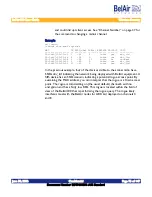
June 30, 2006
Confidential
Document Number BDTM10001-A05 Standard
BelAir100 User Guide
Wireless Security
Example
/# cd radio
/radio# show arm1 wpa1 ssidx 15
wpa1 authen : eap
wpa1 psk key : undef
rekey method : no
update : disabled
state : enabled
Additional Considerations
Make sure to set an access radio SSID other than the default before enabling
WPA1. The BelAir100 unit combines the password phrase with your network’s
SSID to create the WPA1 key.
If WPA1 is already enabled, entering the
set wpa1
command only changes the
specified parameter.
For instance, if you have entered the following command:
set arm1 wpa1 eap rekey kpackets 1000 enabled
The following
set wpa1
command only sets the
update
parameter to
yes
,
without making any other changes.
set arm1 wpa1 update yes enabled
WPA2 Authentication
show arm<n> wpa2 [ssidx <ssid_index>]
set arm<n> wpa2 ( [{eap|psk <secret string>}]
[ssidx <ssid_index>] ) {enabled|disabled}
These commands let you manage WPA2 authentication. It is only available if
your unit contains a radio with part numbers B2CC011AA, B2CC011AB,
B2CC043AA or B2CC033AA. Use the
/system/show phyinv
command to
display the radio’s part number.
Note: The syntax statement for the
set
command contains parentheses ( )
enclosing several parameters (for example,
ssidx
). When you use this
command, you must specify at least one of these parameters.
You can use WPA2 with a pre-shared key. This is suitable, but not
recommended for small networks. The pre-shared key must be between 8 and
63 bytes long. The longer the key, the more secure the connection. The
pre-shared key can be specified as a hexadecimal or ASCII string and must not
contain the following characters:
• exclamation mark (!)
• bar (|)






























